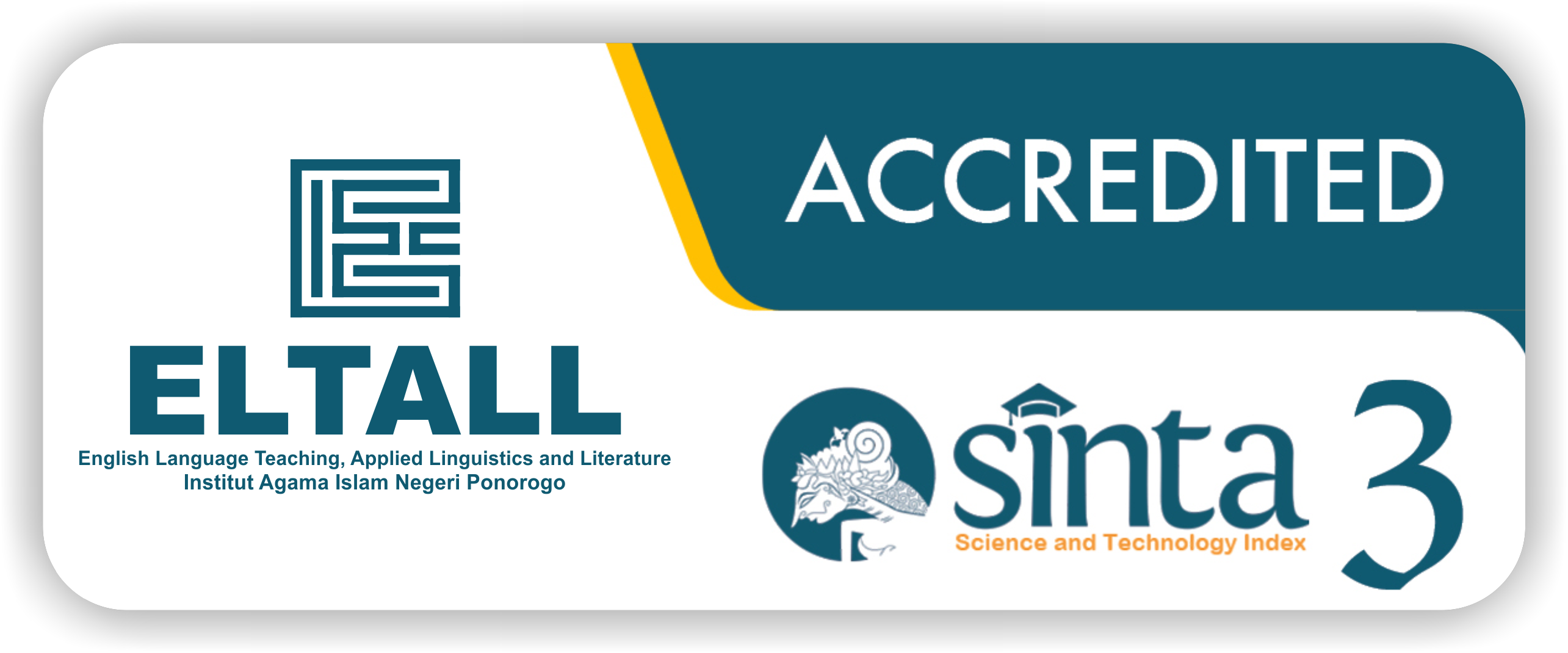Language, Power, and Ideology on Joe Biden's Speech: A Critical Discourse Analysis
DOI:
https://doi.org/10.21154/eltall.v5i2.9724Keywords:
Critical Discourse Analysis, Language and Ideology, Language and PowerAbstract
This study examines Joe Biden's speech delivered during his visit to a Steamfitters training facility in Virginia by using Critical Discourse Analysis (CDA). This research aims to analyze the substance of Biden's speech in the economic sector by examining the text and sociocultural context, using qualitative research methodology by applying Norman Fairclough's framework of critical discourse analysis. Fairclough's Critical Discourse Analysis (CDA) comprises three fundamental components: texts, discourse practices, and sociocultural practices. By using this theory, it is clear that Biden's diction includes specific word categorization through modality, repetition, and the use of first-person singular pronouns to show his full authority and power and to criticize Congressional Republicans. In addition, Biden's speech also served as a political speech and strategic means to rally citizens' support in the United States.
References
Alwi, H. (1992). Modalitas dalam bahasa Indonesia. Penerbit Kanisius.
Collins. (2009). Modals and quasi”modals in world Englishes””COLLINS - 2009””World Englishes””Wiley Online Library. https://onlinelibrary.wiley.com/doi/abs/10.1111/j.1467971X.2009.01593.x
Dijk, T. A. V. (2008). Discourse and Context: A sociocognitive approach.
Dijk, T. A. V. (2015). 22 Critical Discourse Analysis.
Elsharkawy, A. (2017, October 4). What is Critical Discourse Analysis (CDA)?
Fairclough, N. (2003). Analysing Discourse: Textual Analysis for Social Research. Psychology Press.
Fairclough, N. (2013). Critical Discourse Analysis: The Critical Study of Language. Routledge.
Fan, X. (2019). The Research and Application of Critical Discourse Analysis. Journal of Language Teaching and Research, 10(5), 1041. https://doi.org/10.17507/jltr.1005.17
Ghanad, A. (2023). An Overview of Quantitative Research Methods. International Journal of Multidisciplinary Research
Hasanah, U., Alek, A., & Hidayat, D. N. (2019). A Critical Discourse Analysis of Kim Namjoon’s (RM’s) Speech. https://www.semanticscholar.org/paper/A-Critical-Discourse-Analysis-of-Kim-Namjoon%E2%80%99S-Hasanah-Alek/f9ccce50d799248205fed5f794bbc35a51f0f2de
Isti’anah, I. (2023). Journal of Language and Literature. https://e-journal.usd.ac.id/index.php/JOLL/index
Janks, H. (1997). Critical Discourse Analysis as a Research Tool. Discourse: Studies in the Cultural Politics of Education, 18(3), 329”“342. https://doi.org/10.1080/0159630970180302
Koller, V. (2012). How to analyse collective identity in discourse: Textual and contextual parameters. Critical Approaches to Discourse Analysis Across Disciplines, 5(2), Article 2.
Kress, G. R., Leeuwen, T. V., & Leeuwen, T. van. (1996). Reading Images: The Grammar of Visual Design. Psychology Press.
Kusno, A., Rahmad, A., & Bety, N. (2017). Analisis Wacana Kritis Pembentukan Streotip Pemerintah oleh HTI. Bahasa Dan Seni: Jurnal Bahasa, Sastra, Seni Dan Pengajarannya, 45, 143”“154. https://doi.org/10.17977/um015v45i22017p143
Kusumawati, A. J. (2011). A Discourse Analysis Of Sby’s International Speech Text: A Study On Critical Linguistics. Journal of English and Education (JEE), 1”“28. https://doi.org/10.20885/jee.v5i1.4454
Leech, G. N. (1969). A Linguistic Guide to English Poetry. Longman.
Maingeuneau. (2002). Analysis of an academic genre””Dominique Maingueneau, 2002. Retrieved June 25, 2024, from https://journals.sagepub.com/doi/10.1177/14614456020040030401?icid=int.sj-abstract.citing-articles.99
Martika, D., Mahyuni, & Azis, A. D. (2022). Critical Discourse Analysis of Barack Obama Speech. Jurnal Ilmiah Profesi Pendidikan, 7(2c), Article 2c. https://doi.org/10.29303/jipp.v7i2c.65
Pathak, V., Jena, B., & Kalra, S. (2013). Qualitative research. Perspectives in Clinical Research, 4(3), 192. https://doi.org/10.4103/2229-3485.115389
Perkins, M. R. (1983). Modal Expressions in English. F. Pinter.
Sumarlam, S. (2016). Representasi Kekuasaan Melalui Sabda Raja Pada Teks Berita Mengenai Konflik Internal Keraton Yogyakarta (Sebuah Analisis Wacana Kritis). https://doi.org/10.20961/pras.v0i0.1444
Tian, L. (2021). Critical Discourse Analysis of Political Discourse””A Case Study of Trump’s TV Speech. Theory and Practice in Language Studies, 11(5), Article 5. https://doi.org/10.17507/tpls.1105.08
Vadai Kata. (2016). Critical Discourse Analysis in Progress: The Power, Ideology and Manipulation Identification (PIMI) Model. Alkalmazott Nyelvtudomány. Vol. 16. Issue 1. ISSN 1587-1061 (Print), 24984442 (online). https://doi.org/10.18460/ANY.2016.1.004
Waller, L. G. (2006). Introducing Fairclough’s Critical Discourse Analysis Methodology for Analyzing Caribbean Social Problems: Going Beyond Systems, Resources, Social Action, Social Practices and Forces of Structure or Lack Thereof as Units of Analysis (SSRN Scholarly Paper 912329). https://papers.ssrn.com/abstract=912329
Zupnik, J. Y. (1991). Norman Fairclough, Language and power. London: Longman. 1989 Pp. x + 248. Language in Society, 20(2), 265”“269. https://doi.org/10.1017/S004740450001631
Downloads
Published
Issue
Section
License
Copyright (c) 2024 ELTALL: English Language Teaching, Applied Linguistic and Literature

This work is licensed under a Creative Commons Attribution-NonCommercial 4.0 International License.
All articles published in ELTALL (English Language Teaching, Applied Linguistics, and Literature Journal) are licensed under the Creative Commons Attribution-NonCommercial 4.0 International License (CC BY-NC 4.0).
Under this license, authors and readers are free to:
- Share. copy and redistribute the material in any medium or format
- Adapt. remix, transform, and build upon the material
Under the following terms:
- Attribution. You must give appropriate credit, provide a link to the license, and indicate if changes were made. You may do so in any reasonable manner but not in any way that suggests the licensor endorses you or your use.
- Non-Commercial. You may not use the material for commercial purposes.
Notices:
- The licensor cannot revoke these freedoms as long as you follow the license terms.
- No additional restrictions. You may not apply legal terms or technological measures that legally restrict others from doing anything the license permits.
For the full legal code of the license, please visit: https://creativecommons.org/licenses/by-nc/4.0/













